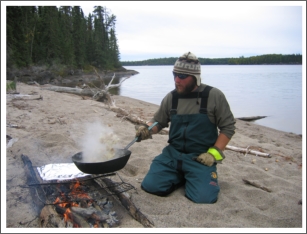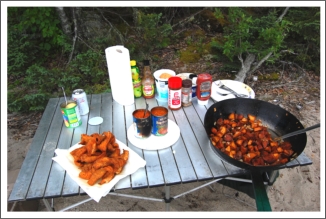SHORELUNCH 101
By: Ben Beattie

No fishing trip is
complete without a shorelunch while out on the lake. Done right, it
can be the best meal you will eat all year. Done wrong, however, and
you'll leave feeling hungry and frustrated with the time you've
wasted. As a full time fishing guide, I've prepared my share of
shorelunches and have perfected the art of a well-executed and tasty
meal for my guests. Use these tips to ensure that your next
shorelunch is cooked to perfection and a memorable experience for
everyone.
BE PREPARED
Pack a shorelunch kit ahead of time that contains everything you will
need to cook your catch. The essentials include: cooking oil, batter for
your fish, onions, pre-cut potatoes, canned beans, utensils, plates, paper
towel, spices, lemons, ketchup, garbage bag and drinks. I also pack large
pans, a foldable table and cooking grates in my boat.
LOCATION
A sandy beach that is out of the wind is the ideal shorelunch spot. If
your lake doesn't have any suitable beaches, an island with a flat rock
surface or clearing will also work. If crown land isn't available be sure
to ask permission before using private property.

PREPARATION
Getting everything set up right is an important step that will ensure
you are back out on the lake catching fish in as little time as possible.
While you cut the fish, have others collect dry wood ranging in size from
tinder to pieces as big around as your arm. For a fire pit, use two logs
or rocks to support your grates and make sure they are level. Leave enough
room under the grates for the firewood. To do this you can build up the
rocks or dig a pit between your logs in the sand using your feet.
COOKING
Cooking perfect golden brown fillets and taters takes practice and oil
temperature is the most important thing. If the oil is too hot, you will
burn your food. If it is too cool the fish and taters will soak up the oil
and feel mushy and taste greasy. To judge when the oil is ready, toss a
piece of potato into the oil while it's heating up. When the potato floats
and is bubbling, your oil is ready to go. For the fish, add the fillets
skin side down to prevent them from curling up. Add butter as they cook
for extra flavour and to help brown the fillets. If the oil gets too hot
your fish will burn. To combat this, you can add more oil or more fillets
to help lower the oil temperature, or remove the pan from the fire
entirely. The fish will float when it's done but you can leave it in
longer if you like a crispier fillet.
Your potatoes should be cut into
the same sized pieces so they will cook uniformly. Depending how many fish
you are frying, the potatoes will generally take longer to cook so start
them first. Add cut up onions five minutes before the taters are done for
added flavour. Spice them as desired; I like seasoning salt and Montreal
steak spice on mine.
CLEAN UP
Remember to pack out all your garbage and pick up what others have
left behind too. Be sure your fire is completely out. Douse it with water
and bury the remaining coals in the sand. Verify with someone else that
they also believe it is out.
SOMETHING DIFFERENT
If you've mastered fried fish and potatoes or just want to experiment
with something different, try these variations. Use a sealed tinfoil pouch
to cook your fish over the fire. Add butter, lemon juice, seasonings,
onions, mushrooms, peppers and tomatoes in with the fish. Cook over coals
until the foil pops up to a dome. For a side dish, try fried rice with
sautéed mushrooms, onions and celery.

Shorelunch is always a memorable
experience for everyone involved, especially those who have never had one
before. It is a time honoured tradition that should be passed on to the
younger generation of fishermen as well. There is nothing wrong with
keeping a few fish for the pan - it's one of the joys of fishing - but
remember to limit your catch, not catch your limit. Bon appetite!

|





